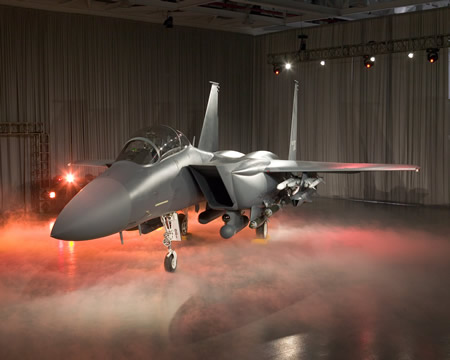South Korea selected an all-new variant of the Pratt & Whitney F100-PW-229 engine for a second batch of Boeing F-15K fighters approved today, helping to preserve Boeing’s 35-year-old production line well into the next decade.
With the exception of the engine choice, the second batch of 21 F-15Ks will be identical to the General Electric-powered first batch of 40 aircraft, including the same mechanically-scanned radar, Boeing F-15 vice president Mark Bass says.
P&W will supply the F100-PW-229EEP with the previously undisclosed enhanced engine package (EEP) for the second batch of aircraft.
The EEP upgrade offers a huge boost in reliability, raising time between overhaul from 4,300 cycles to 6,000 cycles, says a P&W spokesman. The package also adds a real-time health monitoring system and upgraded digital electronic engine control (DEEC) system. The EEP also adds a minor increase in power from 29,000lbs-thrust to 29,100lbs-thrust.
South Korea becomes the third foreign customer to order the EEP upgrade, although the first two buyers remain undisclosed. P&W first quietly tested the package of improvements for the US Air Force in 2004, the spokesman says.

©Boeing
The deal for 21 aircraft allows
The contract means Boeing’s F-15 production backlog is extended through the third quarter of 2012.
Boeing continues to build both F-15Ks and F-15SGs, featuring an active electronically scanned array (AESA) radar, for the Singapore Air Force.
But the manufacturer needs to have signed a new contract before the third quarter of 2009 to avoid a costly gap on the F-15’s 35-year-old production line. Two immediate prospects include replacement F-15s for the Saudi Arabian air force and
A Japanese team conducted a flight evaluation of the F-15E last year at Seymour Johnson Air Force Base,
For the long-term, Boeing continues to hope for a follow-on order by the US Air Force. A previous unsolicited offer to produce 144 new F-15Es has expired, but Boeing stands ready to update the proposal if the USAF shows new interest, Bass says.
USAF leaders have ruled out buying any new combat aircraft that lack inherently stealthy designs, such as the F-35 and the Lockheed F-22.
Meanwhile, the USAF plans to revamp modernization priorities for the F-15E fleet, Bass said. A review of the F-15’s upgrade roadmap is scheduled next month among air force officials representing operations, maintenance and developmental technology.
It’s unclear how the review could impact funding for the F-15E radar modernization programme. In November, Boeing selected the Raytheon APG-63(V) AESA radar for the F-15E upgrade. A contract for a three-year system demonstration and development phase is scheduled to follow in mid- to late-2008, Bass says.
If cleared for export, the same radar may be offered to
Source: FlightGlobal.com























